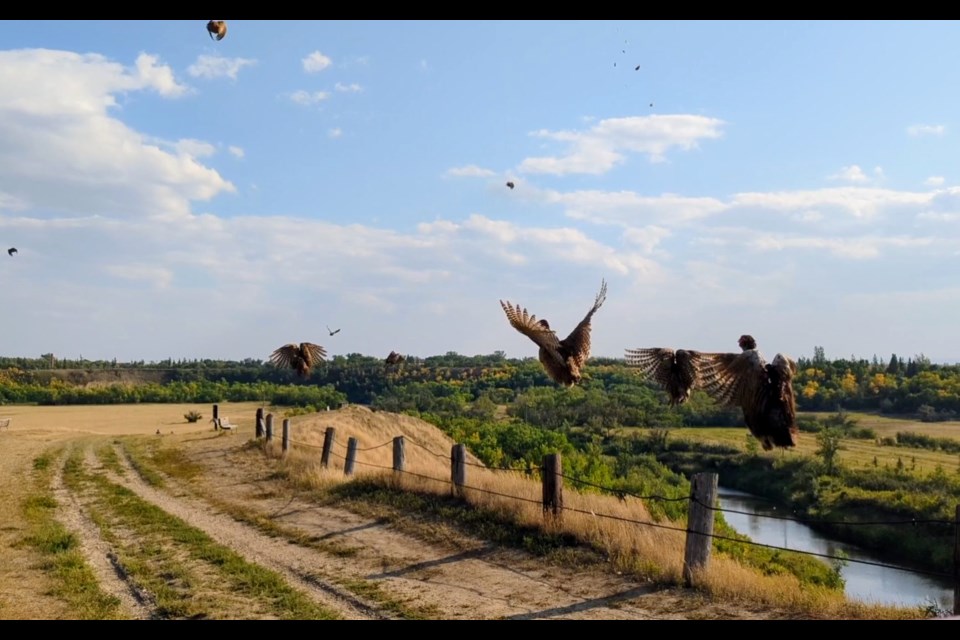Moose Jaw's branch of the Saskatchewan Wildlife Federation (SWF), headed by longtime area president Todd Smith, has been running their Pheasants in the Schools for years now, giving children hands-on experience with wildlife, boosting local ecologies, and supplementing game populations.
The 2023 release of hundreds of locally raised Ring-neck Pheasants has now started, and several families gathered at the end of 4th Ave. SW on Aug. 24 to watch the first few dozen birds scatter into the valley's treeline and shrubbery.
The males are all banded for tracking purposes. The females are illegal to hunt and are more numerous in the wild, so tracking them is less efficient.
“We provide incubators and (Ring-neck Pheasant) eggs to about a dozen classrooms around Moose Jaw, on a yearly basis. And the students hatch those eggs out, and in the process they learn about embryology, the pheasants themselves, they learn about invasive species, native species, habitat needs, and life cycles," Smith explained to the Moose Jaw Express in a March interview.
“And once those chicks are hatched, we raise them over the summer and then release them as adult birds in and around Moose Jaw and southern Saskatchewan to help augment wild populations.”
The chicks are raised to adulthood by local volunteers like Pat Toombs, who loves raising the animals and being part of the program.
"We had a good lot this year, I'm always learning, but some flocks are calmed than others and these ones have been really good," Toombs said. "I've been helping for about six or seven years. In the beginning, I kind of got sucked into it, but I'm really happy to be able to work with Todd and help give back.
"It's such a good program. I have the facilities, I have the food and water, and it's so interesting watching them go from day-old chicks and progressing from there. Things change so quickly. And hopefully we're making a difference in the wild population."
Smith oversees many environmental projects with the Moose Jaw Wildlife Federation (MJWF), including habitat restoration and preservation projects, fish stocking, and education programs. He is also a teacher at École Ducharme (he is fluently bilingual), where his worlds collide, and he creates and continues other ecological education, such as a kestrel box conservation and reporting project managed by his students.
His son Decklan, 12, has been helping his dad with all these programs since infancy.
"I really love this program, it's a good way for students to get to learn the biology, the history, the behaviour of the birds. And every year, it's a little different," Decklan said. "So, it's always pretty interesting to see how the birds turn out, because no two years are the same."
This pheasant species isn't native to North America, Smith explained. As a naturalized inhabitant, they tend to be less resilient than native species. That means the winter cold kills more of them, they are more vulnerable to predators, and they're less wily when being hunted.
"So, we build up and supplement this non-native population, and that supports native bird species," he explained. "These birds provide food for local predator populations, including when they die over the winter. If they're taken home by hunters, that means a native bird was left alone. And they improve the biodiversity, so it's a net gain, unlike more invasive, destructive species like European Starlings. ... Part of being a hunter or a fisherman, loving the outdoors is conservation and protecting habitats. You have to give back and preserve, if you want it to continue."
"I think it's been 15 years, and I've been involved since the start," said MJWF member and volunteer Gord Wilson. "I love pheasant hunting, and I love training dogs, so that's kind of how I look at this. We're augmenting the wild bird population, and I think especially helping predators like coyotes, hawks, owls, over the winter. The predators probably benefit more than the hunters.
"But even with that high attrition rate, you know, these pheasants can survive. We had a male caught last year that had been banded three years before. So, they're out there, it's working."
Follow the Moose Jaw Wildlife Federation on Facebook at facebook.com/MJWildlifeFed to hear about future pheasant release dates.




